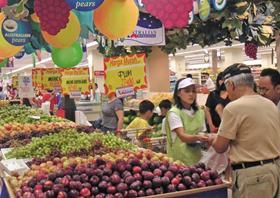
In 2016, Indonesia imported 447,252 tonnes (US$780m) of fruit: a 10 per cent increase from the previous year (405,703 tonnes), but down by about 40 per cent from the peak years of 2011 and 2012 when Indonesia imported about 750,000 tonnes of fruit, before the Indonesian government introduced a range of new import policies.
The main fruits imported in 2016 were temperate fruits, comprising mainly apples (139,926 tonnes), pears (99,653 tonnes), grapes (65,827 tonnes) and mandarins (39,561 tonnes). Over the last ten years there has been an increase in imports of tropical fruits, including longans (mainly from Thailand) with 61,872 tonnes in 2016.
Since the peak years of 2011 and 2012, the main imported fruits that have increased in volume are lemons, grapes and kiwifruit. There has been also an increase in demand for exotic fruits, stonefruits (cherries, plums and peaches) and berry fruits (strawberries followed by blueberries).
China continues to dominate as the major overseas supplier of fruit to Indonesia in 2016, with a 60 per cent share (209,633 tonnes) of all temperate fruit imports. In 2016, China had the major volume share of imported pears, apples and grapes with 84 per cent, 64 per cent and 31 per cent respectively. China is now the major supplier of grapes to Indonesia, for the first time surpassing Australia and the US.



